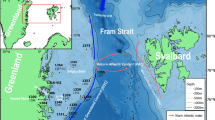Abstract
The abundance and biomass of the deep-sea epibenthic megafauna were studied at three locations in the northeast Atlantic along 20°W longitude. Photographic transects were analyzed to estimate abundance. and catches of an epibenthic sledge and an ottertrawl provided information about taxonomy. individual biomass and size-weight relationships. The highest megafauna density was found at the northernmost site (59°N). where density was twice as high as at 47°N. and at least one order of magnitude higher than at 34°N. The biomass estimates show a similar trend. Pennatulids were the numerically most important group at 59°N and 47°N. In terms of biomass. holothurians predominated at 59°N. and actinarians at 47°N. At 34°N. only a few pennatulids were visible on the photographs. Compared with other regions of similar water depth. the density and biomass of the megafauna at 47°N and 59°N appear to be very high. The importance of the megafauna at 47°N is demonstrated by a high megafauna/macrofauna biomass ratio of about 2.
Access this chapter
Tax calculation will be finalised at checkout
Purchases are for personal use only
Preview
Unable to display preview. Download preview PDF.
Similar content being viewed by others
References
Christiansen, B., O. Pfannkuche & H. Thiel (1990): Vertical distribution and population structure of the necrophagous amphipod Eurythenes gryllus in the West European Basin. Mar. Ecol. Prog. Ser. 66: 35–45.
Grassle, J.F., H.L. Sanders, R.R. Hessler, G.T. Rowe & T. McLellan (1975): Pattern and zonation: a study of the bathyal megafauna using the research submersible Alvin. Deep-Sea Res. 22: 457–481.
Haedrich, R.L. & G.T. Rowe (1977): Megafaunal biomass in the deep sea. Nature 269: 141–142.
Haedrich, R.L., G.T. Rowe & P.T. Polloni (1980): The megabenthic fauna in the deep sea south of New England, USA Mar. Biol. 57: 165–179.
Kaufmann, R.S., W.W. Wakefield & A. Genin (1989): Distribution of epibenthic megafauna and lebensspuren on two central North Pacific seamounts. Deep-Sea Res. 36: 1863–1896.
Khripounoff, A,D. Desbruyères & R. Chardy (1980): Les peuplement benthiques de la faille Vema: donnees quantitatives et bilan d’energie en milieu abyssal. Oceanol. Acta 3: 187–198.
Klein, H. (1987): Benthic storms, vortices, and particle dispersion in the deep West European Basin. Dt. hydrogr. Z. 40: 87–102.
Koblentz-Mishke, O.I., V.V. Volvokinsky & J.G. Kabanova (1970): Plankton primary production of the world ocean. In: W. Wooster (ed.): Scientific Exploration of the South Pacific. Nat. Acad. Sci., Washington, D.C.
Lampitt, R.S., D.S.M. Billett & A.L. Rice (1986): Biomass of the invertebrate megabenthos from 500 to 4100 m in the northeast Atlantic Ocean. Mar. Biol. 93: 69–81.
Mahaut, M.-L., P. Geistdoerfer & M. Sibuet (1990): Trophic strategies in carnivorous fishes: their significance in energy transfer in the deep-sea benthic ecosystem (Meriadzek Terrace-Bay of Biscay). Prog. Oceanog. 24: 223–237.
Ohta, S. (1983): Photographic census of large-sized benthic organisms in the bathyal zone of Suruga Bay, central Japan. Bull. Ocean Res. Inst. Univ. Tokyo 15: 1–244.
Pfannkuche, O. (1990): Makro-, Meiobenthos, Sedimentchemie. In: O. Pfannkuche et al. (eds.): Biologischer Vertikaltransport und und Energiehaushalt in der bodennahen Wasserschicht der Tiefsee. Berichte aus dem Zentrum fur Meeres-und Klimaforschung der Univ. Hamburg. 10: 16–51.
Rice, A.L., R.G. Aldred, E. Darlington & R.A. Wild (1982): The quantitative estimation of the deep-sea megabenthos; a new approach to an old problem. Oceanol. Acta 5: 63–72.
Richardson, M.J. & C.D. Hollister (1987): Compositional changes in particulate matter on the Iceland Basin, through the water column, and at the seafloor. J. Mar. Res. 45: 175–200.
Rowe, G.T. & R.J. Menzies (1969): Zonation of large benthic invertebrates in the deep sea off the Carolinas. Deep-Sea Res. 16: 531–581.
Russell, R.A. & J. Serafy (1986): Deep-sea demersal fish density estimates compared from simultaneous net catches and photography. Oceanol. Acta 9: 503–508.
Ruttgers van der Loeff, M.M. & M.S.S. Lavaleye (1986): Sediments, fauna and the dispersal of radionuclides at the N.E. Atlantic dumpsite for low-level radioactive waste. Report of the Dutch DORA program. Netherlands Institute for Sea Research. Den Burg, 134 pp.
Sibuet, M., C. Monniot, D. Desbruyères, A. Dinet, A. Khripounoff, G. Rowe & M. Segouzac (1984): Peuplements benthiques et caracteristiques trophiques du milieu dans la plaine abyssale Demarara. Oceanol. Acta 7: 345–358.
Smith, C.R. & S.C. Hamilton (1983): Epibenthic megafauna of a bathyal basin off southern California: patterns of abundance, biomass, and dispersion. Deep-Sea Res. 30: 907–928.
Thiel, H., O. Pfannkuche, G. Schriever, K. Lochte, A.J. Gooday, C.h. Hemleben, R.F.G. Mantoura, C.M. Turley, J.W. Patching & F. Riemann (1988/89): Phytodetritus on the deep-sea floor in a central oceanic region of the Northeast Atlantic. Biol. Oceanogr. 6: 203–239.
Thorson, G. (1957): Bottom communities (Sublittoral or Shallow Shelf). In J.W. Hedgpeth (ed.): Treatise on marine ecology and paleoecology 1: Ecology. Mem. Geological Society of America, New York: 461–534.
Author information
Authors and Affiliations
Editor information
Editors and Affiliations
Rights and permissions
Copyright information
© 1992 Springer Science+Business Media Dordrecht
About this chapter
Cite this chapter
Christiansen, B., Thiel, H. (1992). Deep-Sea Epibenthic Megafauna of the Northeast Atlantic: Abundance and Biomass at Three Mid-Oceanic Locations Estimated From Photographic Transects. In: Rowe, G.T., Pariente, V. (eds) Deep-Sea Food Chains and the Global Carbon Cycle. NATO ASI Series, vol 360. Springer, Dordrecht. https://doi.org/10.1007/978-94-011-2452-2_8
Download citation
DOI: https://doi.org/10.1007/978-94-011-2452-2_8
Publisher Name: Springer, Dordrecht
Print ISBN: 978-94-010-5082-1
Online ISBN: 978-94-011-2452-2
eBook Packages: Springer Book Archive




